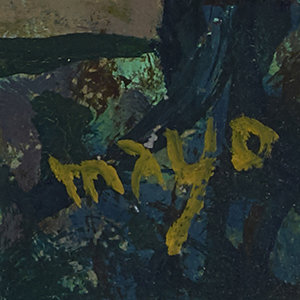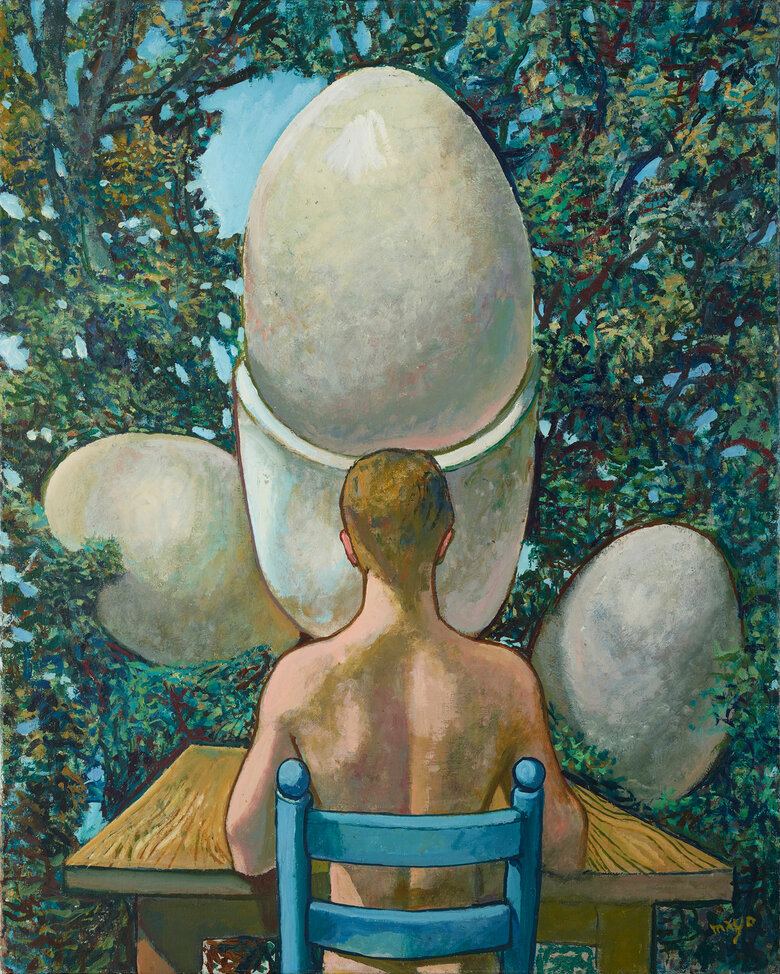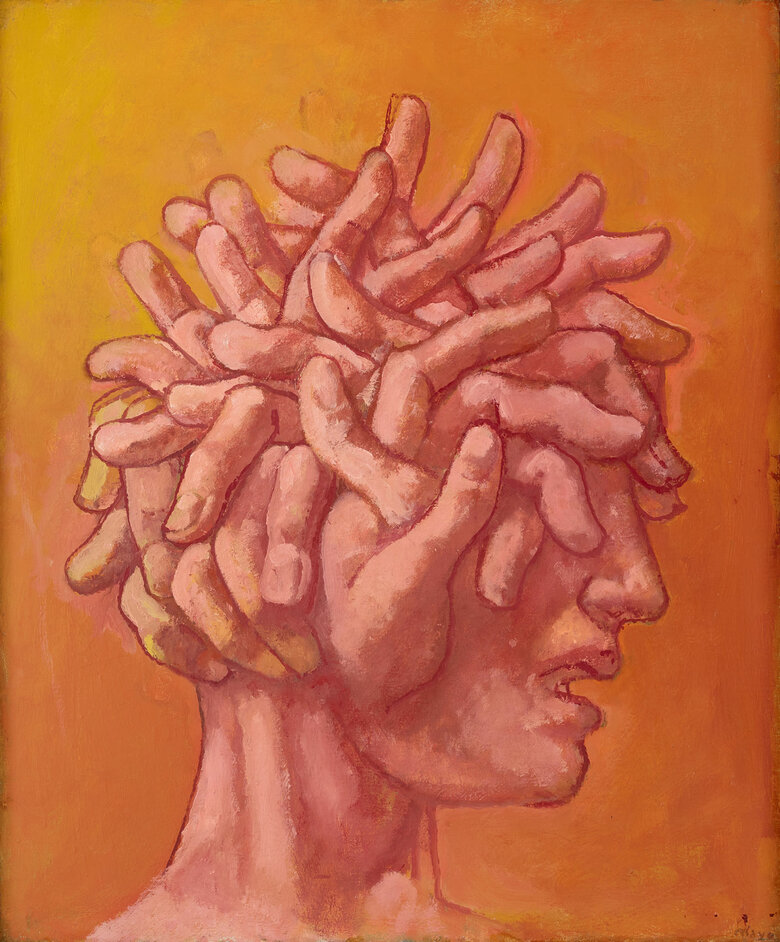Born in 1905 in Port Said, Egypt, to a Greek father, who was engineer for the Suez Canal and a French mother, Antoine Malliarakis, is better known as Mayo. In 1910, he started his education in...


ANTOINE 'MAYO' MALLIARAKIS, Egypt (1905 - 1990)
Bio
Written by ARTHUR DEBSI
Born in 1905 in Port Said, Egypt, to a Greek father, who was engineer for the Suez Canal and a French mother, Antoine Malliarakis, is better known as Mayo. In 1910, he started his education in Ismailia, North East Egypt, and pursued it in a Jesuit school in Alexandria. Since very young, Mayo showed an interest in art, especially aquarelle, and drawing; which led him in travelling to France in 1923. There, he studied architecture, and painting at the École Supérieure des Beaux-Arts in Paris, before going to Berlin in 1928, where he joined the French writer René Crevel (1900-1935), and started working in the studio of the German expressionist Rudolf Levy (1875-1944). Back to France in 1929, he collaborated to the review called Le Grand Jeu, that was co-founded by his friend, and para-Surrealist poet Roger Gilbert-Lecomte (1907-1943). In 1933, Mayo returned to Egypt, but would eventually go back to France, where he settled in villa Seurat in Paris in 1935. He then decided to relocate in Rome in 1966, but an eye infection pushed him to go back to Paris in 1986.
Going back and forth to Egypt from 1933 to 1934, and again between 1937 and 1941, Mayo contributed to the elaboration of the Art and Liberty group, founded in 1938 in Cairo by the Egyptian poet Georges Henein (1914-1973). The Surrealist group developed in Egypt in opposition to academism promoted by the local art education, and the Westernized Egyptian culture. Although Mayo had never been officially part of the movement, he did exhibit with the group, and also produced some illustrations, which accompanied texts, written by the group’s members, such as the French author of Egyptian origin, Edmond Jabès (1912-1991)[1]. However, it seems that Mayo, as well as his works, were more related to the movement of Surrealism in Paris, since he actually spent most of his lifetime in France.
In parallel of his artist career, Mayo is also known to be costume designer for theater, especially for the Théâtre des Mathurins in Paris. In 1943, the French film director Marcel Carné (1906-1996) started the shooting of Les Enfants du Paradis, and for the first time, Mayo was appointed costume designer for a film.[2]
The experience of Mayo in Paris was highly enriching. He effectively arrived in France within the Roaring Twenties, when the capital city was in turmoil. The latter attracted local, and international, artists, performers, musicians, and writers, who all contributed to the emergence of innovative cultural movements. Among these movements, Surrealism imposed itself as a new, and avant-garde form of expression, in response to the atrocities caused by World War I[3]. Published in 1924 by the French poet, and writer André Breton (1896-1966), The Surrealist Manifesto laid the foundation of the movement, which aimed to free the conscious from the rational life in art, poetry, and literature. Mayo quickly integrated the intellectual, and artistic circles, by frequenting the famous, and lively neighborhood of Montparnasse. He encountered some important figures from the Surrealist movement like the American painter, and photographer Man Ray (1890-1976), the French poet Robert Desnos (1900-1945), and the Romanian writer Tristan Tzara (1896-1963). In his early works in Paris, Mayo used to fiddle with the colors on the canvas[4], and the figures – often human –, that he illustrated in his compositions, look imposing, and massive. He would always be inspired by people from his environment, and sometimes emphasized on the dramatic aspect in some scenes.
It is important to note that the oeuvre of Mayo is hard to precisely define. With his refusal to be part of the Surrealist movement, whether in Cairo, or in Paris, the artist consequently imposed a personal style. Instead of following pure artistic, and theoretical principles, he preferred to combine inspirations, and aesthetics from realism, surrealism, and poetry. Since the beginning, he had constantly expressed a certain mystery, and calmness in his paintings, and put the human in the core of his creative process. Yet, he didn’t really work on the plastic interpretation of the subconscious, and Freudian theories[5].
From the late 1960s to the 1980s, Mayo stayed in Rome, and produced works, that tackle the theme of metamorphosis, in connection with the Latin poem Metamorphoses, written by Ovide (43 B.C.- 18 A.D.) in 8 A.D. In the work entitled Homme de Profil (Profile of a Man), part of the Dalloul Art Foundation’s collection, the use of a palette of warm colors demonstrates the research, and work of the painter on light. He applied a gradation of tones of orange and yellow, seeking for the luminosity through the contrasts. Mayo depicted the face of a man, whom the features recall the ancient Roman sculpture. The artist replaced the hair with entangled fingers, in order to represent the constantly working brain, which all individuals experience in their lives. This shows the complexity of the human thinking, to the extent that the character seems to be suffering, as his mouth might indicate fear, or even scream.
In this ‘Roman’ stage of the artist’s career, the iconography largely includes symbolic elements such as stones, walls, cascades, and animals like horses, and birds. Through a spontaneous painting, Mayo created enigmatic, and erotic scenes, where all these motifs interact with each other, like in a dreamlike world. In La Vie Augmente Toujours (Life Always Evolves), dated from 1970, and also part of the Dalloul Art Foundation’s collection, a naked man seen from behind, is sitting at a wooden table, and is surrounded by trees. The most striking element of this composition is the three giant eggs in front of the protagonist, and whom the shells appear to be as hard as stones. According to Mayo, the nest was seen as a protector of life, and the egg was conceived as the essence of life. Thus, he celebrated the cycle of life, incorporating various elements of animal, vegetal, and human origin.
The artistic specificity, or affiliation of Antoine Malliarakis, was always separated between the places, where he lived, and the different movements, that he discovered. This particularity is the very image of the art from a cosmopolitan world, in which Egyptian, Greek, and French people met. Through all of these cultural exchanges in the 20thcentury, modern art built cultural bridges, and the artists from diverse backgrounds enriched each other.
Antoine Malliarakis passed away in Seine Port, France, in 1990.
Notes
[1] Bardaouil, Sam, and Fellrath, Till. Art Et Liberté, Rupture, War and Surrealism in Egypt (1938-1948), [Exhibition catalogue, ‘Art Et Liberté, Rupture, Guerre Et Surréalisme En Égypte (1938-1948)’. Paris, Centre Georges Pompidou, October 19th 2016 – January 16th 2017]. Paris, France: Skira, 2016. [P.216]
[2] “Les Films De Jacques Prévert Et Leurs Costumes.” Accessed September 23, 2020. http://www.cerpcos.com/les-films-de-jacques-prevert-et-leurs-costumes/2018/11/.
[4] “Chronologie: Antoine Malliarakis, Dit MAYO(1905-1990).” Chronologie | Antoine Malliarakis, dit MAYO(1905-1990). Accessed September 21, 2020. http://mayo-peintre.com/chrono/index.html.
[5] “Chronologie: Antoine Malliarakis, Dit MAYO(1905-1990).” Chronologie | Antoine Malliarakis, dit MAYO(1905-1990). Accessed September 21, 2020. http://mayo-peintre.com/chrono/index.html.
Sources
Bardaouil, Sam, and Fellrath, Till. Art Et Liberté, Rupture, War and Surrealism in Egypt (1938-1948), [Exhibition catalogue, ‘Art Et Liberté, Rupture, Guerre Et Surréalisme En Égypte (1938-1948)’. Paris, Centre Georges Pompidou, October 19th 2016 – January 16th 2017]. Paris, France: Skira, 2016.
Kanafani, Fatenn Mostafa. “The Permanent Revolution: From Cairo to Paris with the Egyptian Surrealists,” 2016. https://www.academia.edu/30032558/The_Permanent_Revolution_From_Cairo_to_Paris_with_the_Egyptian_Surrealists.
Kane, Patrick. "Art Education and the Emergence of Radical Art Movements in Egypt: The Surrealists and the Contemporary Arts Group, 1938-1951." The Journal of Aesthetic Education 44, no. 4 (2010): 95-119. Accessed September 10, 2020. https://www.jstor.org/stable/10.5406/jaesteduc.44.4.0095
The Editors of Encyclopaedia Britannica. “Surrealism,” May 28, 2020. https://www.britannica.com/art/Surrealism.
“Chronologie: Antoine Malliarakis, Dit MAYO(1905-1990).” Chronologie | Antoine Malliarakis, dit MAYO(1905-1990). Accessed September 21, 2020. http://mayo-peintre.com/chrono/index.html.
Havard, Anne-Marie. “Le Grand Jeu, Entre Illusio Et Lucidité.” COnTEXTES. Revue de sociologie de la littérature. Groupe de contact F.N.R.S. COnTEXTES, September 1, 2011. https://journals.openedition.org/contextes/4844.
“Les Films De Jacques Prévert Et Leurs Costumes.” Accessed September 23, 2020. http://www.cerpcos.com/les-films-de-jacques-prevert-et-leurs-costumes/2018/11/.
CV
Selected Solo exhibitions
1986
Mayo: Retour d’Italie, Musée des Arts Décoratifs, Paris, France
1948
Galerie Dina Vierny, Paris, France
1933
Cercle du Canal de Suez, Ismailia, Egypt
1930
Galerie des Quatre Chemins, Paris, France
Selected Group Exhibitions
2024
Arab Presences: Modern Art And Decolonisation: Paris 1908-1988, Musée d'Art Moderne de Paris, Paris, France
Surrealism: Le Grand Jeu, MCBA, Musée cantonal des Beaux-Arts Lausanne, Lausanne, Switzerland
The Collector´s Eye XI, Ubuntu Art Gallery, Cairo, Egypt
2023
UNTITLED Abstractions, Dalloul Art Foundation, Beirut, Lebanon
2022
Surrealism Beyond Borders, Tate Modern, London, United Kingdom
2021
Monaco-Alexandrie, le grand detour. Villes-Mondes et surréalisme cosmopolite, NMNM – Villa Sauber, Monaco, France
Surrealism Beyond Borders, The Metropolitan Museum of Art, New York, United States
2019
From Mokhtar to Gazbia, ArtTalks Egypt, Cairo, Egypt
2018
Art et Liberté, Rupture, War and Surrealism in Egypt (1938-1948), Moderna Museet, Stockholm, Sweden
Art et Liberté, Rupture, War and Surrealism in Egypt (1938-1948), Tate Liverpool, Liverpool, United Kingdom
2017
Art et Liberté, Rupture, War and Surrealism in Egypt (1938-1948), Kunstsammlung Nordrhein-Westfalen,Düsseldorf,Germany
Art et Liberté, Rupture, War and Surrealism in Egypt (1938-1948), Museo Nacional Centro de Arte Reina Sofia, Madrid, Spain
2016
Art et Liberté, Rupture, guerre et surréalisme en Égypte (1938-1948), Centre Pompidou, Paris, France
1930
Galerie Bonaparte, Paris, France
1929
Galerie des Quatre Chemins, Paris, France
1928
Flechsteit Gallery, Berlin, Germany
Awards and Honors
1986
Commandeur des Arts et des Lettres
Collections
European Cultural Centre of Delphi, Athens, Greece
Kunstsammlung Nordrhein-Westfalen, Düsseldorf, Germany
Mathaf: Arab Museum of Modern Art, Doha, Qatar
May Moein Zeid & Adel Youssry Khedr collection, Cairo, Egypt
The Agricultural Museum, Cairo, Egypt
The Barjeel Art Foundation, Sharjah, United Arab Emirates
The Museum of Modern Egyptian Art, Cairo, Egypt
The Ramzi and Saeda Dalloul Art Foundation, Beirut, Lebanon
ANTOINE 'MAYO' MALLIARAKIS Artwork
Become a Member
Join us in our endless discovery of modern and contemporary Arab art
Become a Member
Get updates from DAF
Follow Artists
Save your favourite Artworks
Share your perspectives on Artworks
Be part of our community
It's Free!
We value your privacy
TermsCookiesPrivacy Policies
Become a Member
Get updates from DAF
Follow Artists
Save your favourite Artworks
Share your perspectives on Artworks
Be part of our community
It's Free!
We value your privacy
TermsCookiesPrivacy Policies
Become a Member
Get updates from DAF
Follow Artists
Save your favourite Artworks
Share your perspectives on Artworks
Be part of our community
It's Free!
We value your privacy
TermsCookiesPrivacy Policies
Welcome to the Dalloul Art Foundation
Thank you for joining our community
If you have entered your email to become a member of the Dalloul Art Foundation, please click the button below to confirm your email and agree to our Terms, Cookie & Privacy policies.
We value your privacy, see how
Become a Member
Get updates from DAF
Follow Artists
Save your favourite Artworks
Share your perspectives on Artworks
Be part of our community
It's Free!
We value your privacy
TermsCookiesPrivacy Policies






